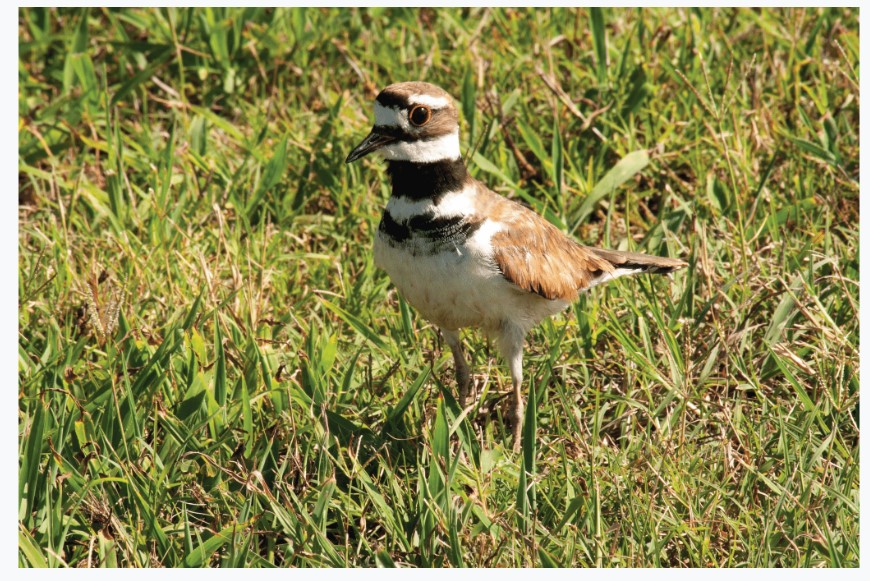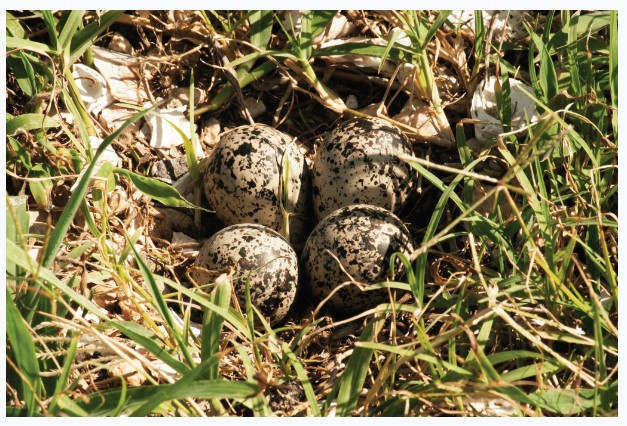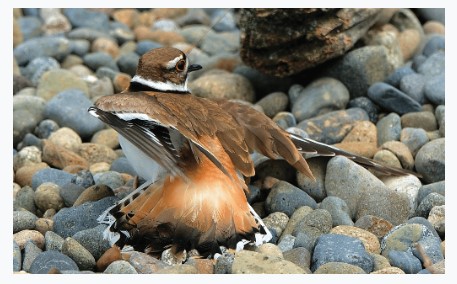Stop, look and listen wherever you may be on Galveston Island, and you may spot a killdeer nearby. Why such a strange name for a bird? Killdeer come by their name because of the loud shrill call they make that literally sounds like “Kill-deer! Kill-deer!” The scientific name Charadrius vociferous also makes reference to the big voice that comes from this “vociferous” bird.
Killdeer are brownish-tan on the upperparts and white underneath. Two black bands partially circle the white chest and neck, making them easy to spot and identify. Killdeer have a brown face with white and black patches and a bright orange rump can be seen when they are in flight. Both male and female have the same color markings. The average body length of the killdeer is between 8-11 inches, with a wingspan of 18-19 inches.
 Town & Country
Town & Country
Killdeer are common and widespread due to their capacity to thrive in all types of habitats. Members of the plover family of shorebirds, they are at home along the island’s shoreline and salt marshes, as well as on the banks of fresh water ponds. Lands used for agriculture, such as livestock pastures, open fields, and farmland, also provide prime real estate for killdeer.
Their uncanny ability to adapt to urban landscapes allows the killdeer to live alongside people in many places. Taking advantage of virtually everything that humans create, they will make their homes on large suburban lawns, public parks, school yards, golf courses, athletic fields, airports, flat gravel rooftops, and parking lots.
A good habitat includes almost anywhere that the killdeer can find a good meal, and their feeding behavior is noticeably erratic. A killdeer will run a short distance, stop abruptly, look around while bobbing its head, then run again. This run-and-pause technique works well when foraging for insects, and the killdeer often stirs up a grasshopper, spider, beetle, worm or snail. On well-lit parking lots in suburban areas, killdeer can be seen running and bobbing throughout the night in search of insects.
Living Dangerously
Upon choosing a mate, the killdeer couple will work together to choose a suitable place for a nest. However, a suitable place to the killdeer is on the ground rather than high in the tree branches. Once the spot is chosen, they scrape out a slight depression in the ground before adding a few rocks or shells. The nest is  such a simple structure that it naturally blends in with the surrounding grass, rocks or scattered gravel on a parking lot.
such a simple structure that it naturally blends in with the surrounding grass, rocks or scattered gravel on a parking lot.
After mating, the female lays a clutch of four light brown eggs that are blotched with dark brown and black spots. The spotted eggs resemble stones, serving to camouflage the nest even further. Now comes the long haul of the 24 to 28-day incubation period. Both parents will spend all of their time sitting on the eggs and teaming up to guard the nest around the clock.
Born to Boogie
Baby killdeer chicks are precocial, meaning that within hours of hatching, they will leave the nest and begin to walk and run on their own. Compared to altricial birds that are nest bound and require parental feeding and care, the soft feathered killdeer hatchlings scurry around the parents’ legs from day one, and immediately learn to feed themselves.
Precocial birds stay inside of the egg much longer than altricial birds, and this longer incubation period allows more time for development before hatching. Although young killdeer are more independent than most baby birds, they still stay under the protective watch of their parents until first flight at roughly 25 days.
Drama Queen
With a vulnerable nest of eggs on the ground or several young chicks in tow, killdeer parents must always be on the lookout for predators. One tricky way the killdeer protects the nest is to act as a diversion or distraction when threatened. Often called the “broken wing act,” the killdeer acts as a decoy, enticing a predator to follow what appears to be an easy target.
 When the nest is in danger, the female leaves the nest and begins performing quite a show. Feigning injury, she will drag one or both wings along the ground as if broken and cry out loudly as if hurt. However, when pursued, she deftly flutters just out of reach time and again until the predator is lured far away.
When the nest is in danger, the female leaves the nest and begins performing quite a show. Feigning injury, she will drag one or both wings along the ground as if broken and cry out loudly as if hurt. However, when pursued, she deftly flutters just out of reach time and again until the predator is lured far away.
If an intruder does not initially follow, she will precariously move in closer, making more noise in order to garner its attention. The male or other killdeer may join in screaming protests to gang up on the predator.
False brooding is another diversionary act. The killdeer will settle down on the ground as if sitting on a nest, yet there is not really a nest there at all. When the predator arrives at the fake nest site, the bird will fly away to another false nest site. Designed to throw the predator off the trail of the true nest, the killdeer will continue the charade until the predator becomes confused or bored.
To keep grazing livestock at bay, the killdeer parent performs an entirely different act. Cattle and horses are not true predators, but their large hooves can prove quite dangerous to fragile eggs unprotected on the ground. The killdeer will fluff up all its feathers, including raising its tail feathers and displaying them above its head. Appearing bigger and thus more threatening, it will charge straight at the larger animal, attempting to change its path.
 Fitting into the Ecosystem
Fitting into the Ecosystem
Killdeer are classified as migratory species, but they are year-round residents here on Galveston Island because of the island’s warm climate. The population of the killdeer is listed as stable, in part due to their ability to adapt to urban areas. Even so, moving into a new neighborhood brings potential threats, including vehicles, pesticides, and domesticated cats and dogs.
With all of their interesting behavior, killdeer make great subjects for bird watching; however, when humans come too close to a nest or hatchlings they are often perceived as a threat. If killdeer engage in distraction behaviors, it is important to allow the parents sufficient space to safely protect their family.